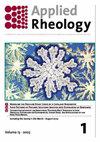未固化橡胶熔体剪切流变行为的建模
IF 1.8
4区 工程技术
Q1 MECHANICS
引用次数: 0
摘要
摘要为了描述未固化橡胶熔体流动,提出了一个改进的Phan–Thien–Tanner(PTT)模型来表征流变行为,并根据不可压缩流体建立了粘弹性一维流动理论。构造了相应的数值方法来确定解。进行了旋转流变实验来验证所提出的模型。通过比较计算粘度和实验粘度,研究了本构模型中参数的影响,以确定最合适的参数。未固化橡胶的粘度比塑料的粘度大3-4个数量级,并且没有可见的牛顿区域。与Cross Williams Landel Ferry(Cross WLF)和原始PTT模型相比,如果参数设置正确,修改后的PTT模型可以描述整个剪切速率区域的流变特性。本文章由计算机程序翻译,如有差异,请以英文原文为准。
Modeling of Shear Rheological Behavior of Uncured Rubber Melt
Abstract To describe uncured rubber melt flow, a modified Phan–Thien–Tanner (PTT) model was proposed to characterize the rheological behavior and a viscoelastic one-dimensional flow theory was established in terms of incompressible fluid. The corresponding numerical method was constructed to determine the solution. Rotational rheological experiments were conducted to validate the proposed model. The influence of the parameters in the constitutive model was investigated by comparing the calculated and experimental viscosity to determine the most suitable parameters. The uncured rubber viscosity was 3–4 orders larger than that of plastic and did not have a visible Newtonian region. Compared with the Cross-Williams-Landel-Ferry (Cross-WLF) and original PTT models, the modified PTT model can describe the rheological characteristics in the entire shear-rate region if the parameters are set correctly.
求助全文
通过发布文献求助,成功后即可免费获取论文全文。
去求助
来源期刊

Applied Rheology
物理-力学
CiteScore
3.00
自引率
5.60%
发文量
7
审稿时长
>12 weeks
期刊介绍:
Applied Rheology is a peer-reviewed, open access, electronic journal devoted to the publication in the field of applied rheology. The journal provides the readers with free, instant, and permanent access to all content worldwide; and the authors with extensive promotion of published articles, long-time preservation, language-correction services, no space constraints and immediate publication.
 求助内容:
求助内容: 应助结果提醒方式:
应助结果提醒方式:


